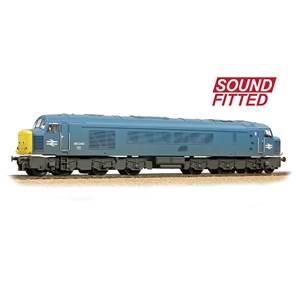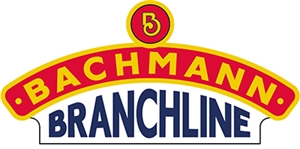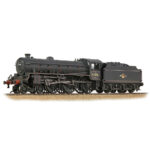The popular Class 46 Diesel Locomotive returns to the Bachmann Branchline range with this OO scale model depicting No. 46045 in BR Blue livery after its headcode panels were removed and sealed beam headlights were fitted. Together with the Class 44s and 45s the classes were commonly known as the ‘Peaks’, because the Class 44s had been named after mountains in England and Wales, however all but one of the 56 Class 46s went unnamed.
The Bachmann Branchline model combines a finely-proportioned bodyshell with extensive detailing throughout, including separately fitted cab handrails, windscreen wipers, lamp brackets and sandpipes. With a powerful 5-pole motor fitted with twin flywheels which drives both bogies, these models have plenty of pulling power to haul even the longest trains. This model is supplied with SOUND FITTED, allowing realistic sound effects to be enjoyed on both DCC or Analogue Control straight out of the box!
MODEL FEATURES:
- Bachmann Branchline OO Scale
- Era 7
- Weathered BR Blue livery
- Running No. 46045
- Locomotive is now Preserved
- Sealed Beam Headlights
- NEM Coupling Pockets
- Sprung Buffers
- Powerful 5 Pole Motor with Twin Flywheels
- Detailed Cab Interior with pre-fitted Driver in one cab
- Directional Lighting
- Accessory Pack
- SOUND FITTED – Fitted with a ESU V5DCC Sound Decoder – See below for the function list
- Length 275mm
SOUNDS
F0 – Directional Lights – On/Off (plus Light Switch Sound)
F1 – On – Fuel Pump On – Warm Engine Start
F1 – On/Off – Fuel Pump On – Failed Engine Start Latch Single
F1 – On/Off/On – Fuel Pump On – Cold Engine Start
F2 – Brake
F3 – Single Horn (Playable)
F4 – Two-Tone Horn
F5 – Drive Hold (also known as Speed Lock)
F6 – Coasting
F7 – Coupling Up & Brake Pipe Connect
F8 – Uncoupling, Brake Disconnect & Vac Destroyed
F9 – Flange Squeal
F10 – Air Dump
F11 – Spirax Valve
F12 – On – Guard’s Whistle / Off – Driver’s Response
F13 – N/A
F14 – Auto Uncouple Cycle Latch –
F15 – On – Driver’s Door Open / Off – Driver’s Door Shut
F16 – AWS Horn
F17 – AWS Bell
F18 – Windscreen Wipers
F19 – Latch – Mute / Trigger – Cycle through 6 Volume Levels
Analogue Users: Directional lights and basic Prime Mover (engine) sounds, which vary with speed, plus any other automated sounds, can be enjoyed when using this model on analogue control (DC) straight from the box!
CLASS 46 HISTORY
The Class 46 1Co-Co1 BR-Sulzer Type 4 locos were built from 1961–1963 at British Railways’ Derby Works and were initially numbered D138–D193. With the arrival of TOPS they were renumbered to Class 46. Fifty-six locomotives were built. The first was withdrawn in 1977 and all of them were withdrawn by the end of 1984. Class 46s began their lives with twin headcode panels situated in the centre of the nose, and later built examples a single central headcode panel, to which all class members were progressively converted. The majority received plated over nose ends with sealed beam headlights in the 1970s. Liveries worn were standard BR lined green, ‘austerity’ green without the cream embellishments of the original livery, and BR Blue with full yellow ends.
The Class 46 design was structurally the same as the preceding Class 45 build, and had the same Sulzer engine, but differed in the fitment of a Brush generator and traction motors, in place of the Crompton Parkinson equipment fitted to the Class 45. Along with the other Sulzer Class 44 and 45 designs they are often referred to as “Peaks”, so named because the earliest of the Class 44 were named after mountains.
Despite intermittent use on freight trains, Class 46s were regular performers on passenger turns, particularly North East-South West, Trans-Pennine and secondary North East-London trains, and depot allocations reflected this with locos at Gateshead and Plymouth in 1977 giving a typical spread. Freight workings were also quite often worked over long distances, particularly “clay hoods” carrying china clay from Cornwall to the area around Stoke-on-Trent. In the 1980s the remaining locomotives were concentrated at Gateshead depot, and the final booked passenger workings for the class were the dated summer Saturday services Bradford – Weymouth (between Bradford and Birmingham New Street), Newcastle – Plymouth, Newcastle – Blackpool North, and York – Blackpool North. The Class 46s also worked several named expresses including the Yorkshire Pullman, Flying Scotsman, Hull Executive, Thames-Clyde and Thames-Forth, also known as The Waverley, on the much lamented route from Carlisle to Edinburgh via Hawick.



















